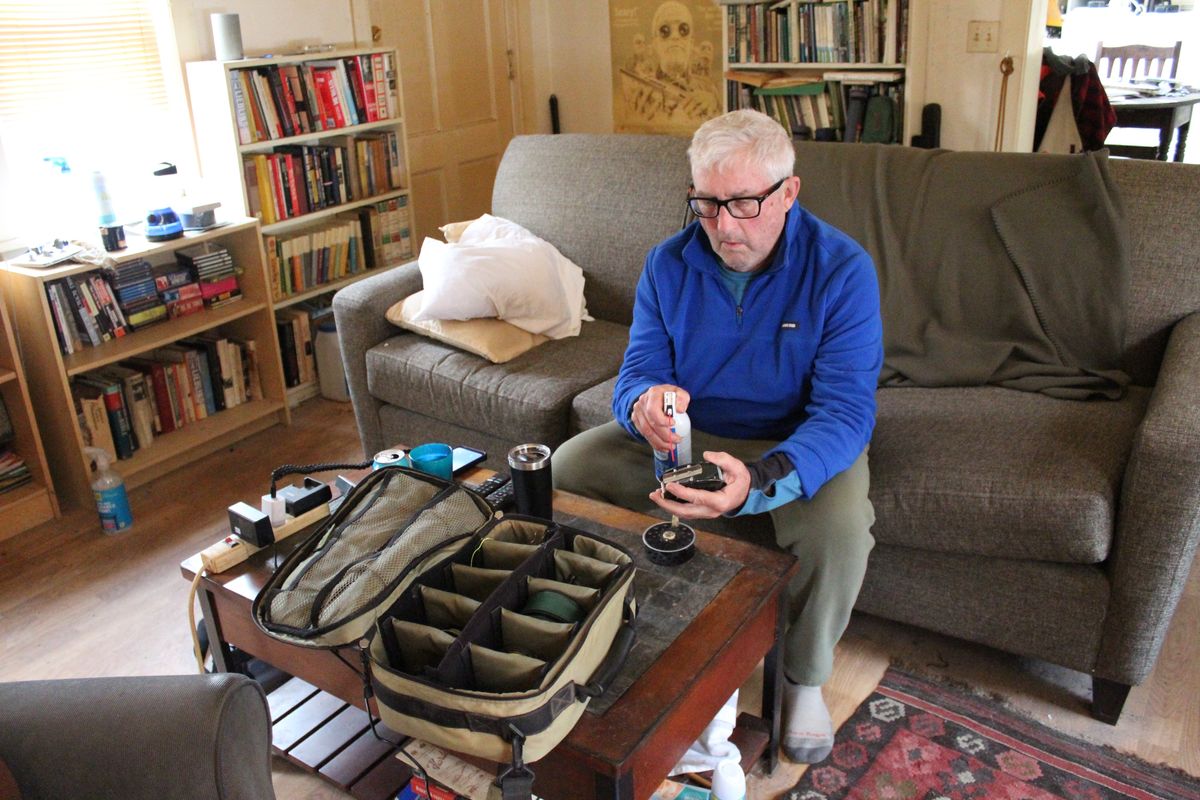Tangled tackle fondling 2025

A can of compressed air is handy for getting last year's grit and gunk out of your gear. It also wouldn't hurt to clean the car out more than once a year.
Patrick L. Sullivan

A can of compressed air is handy for getting last year's grit and gunk out of your gear. It also wouldn't hurt to clean the car out more than once a year.
The Super Bowl is over, pitchers and catchers have reported for spring training, and that means spring is around the corner.
Which in turn means it’s time for the annual Tangled Lines Tackle Fondling report.
I noticed the reel bag, which has traveled around in the car for at least one full year, was full of dirt. This was in addition to reels, waterproof matches, a knife, and the extra pair of polarized sunglasses that I tore the car apart looking for back in October.
Hmmm. Maybe the definition of “tackle fondling” should be expanded to include “car cleaning.”
Anyhoo, I went to the hardware store, bought a can of compressed air, and started blasting the dirt, sand and grit out of the reels that float around loose all year in the reel bag.
While doing this I clipped off ancient brittle leaders and noted which lines needed cleaning and dressing.
Not a difficult process. They all need cleaning and dressing. Anglers don’t do this often enough. I do it a couple times a year, and as needed when my floating line stops floating.
Some people use hand wipes, the kind that come in a little packet. You can get them cheap online.
I’m even cheaper, however, so I use Dawn dish soap, which cleans everything from fly lines to birds caught in oil spills. You can even do the dishes with it.
I make a weak solution, defined as one cup or so of warm water with one small blob of Dawn dish soap. Stir until frothy, and dunk a brand new sponge in it.
Run your line through the sponge, recharging as needed. You’ll see the yick come off on the sponge.
For dressing regular PVC-coated fly lines, you can use Mucilin green label line dressing, which has silicone in it. Or you can use Albolene, which is a face cream designed to remove theatrical makeup. A tub of Albolene costs about the same as one dinky little thing of Mucilin. But the dinky thing is a lot easier to carry.
For dressing your silk lines, I refer you to Izaak Walton’s “On Ye Dressynge of Ye Snootye Sillye Silke,” 1655.
Next up, the waders and boots.
I have four pairs of waders, one is right out of the box. None have patches or known leaks. So, fingers crossed.
On boots, I have four pairs, felt and rubber soled, sizes 9 and 10. Looking them over, I see some studs have come out of the rubber soles and they have stayed put in the felt. So that means replacing a few here and there and hoping for the best.
Wading sticks: I have several, and I fully expect at least one to fail this year. So I have spares, both of the collapsible type, and the trekking poles which are adjustable but do not fold up and go into a holster.
Rods: I only have one new rod to test out, a Chinese-made bamboo number that is an experiment.
Fly boxes: I am not even going to pretend to sort this out. I’m just going to pick up where I left off.
But I am NOT buying any flies until I use up what I have. And since I have thousands…
Next time we’ll go back to the Tangled Lines medical report, featuring Mohs surgery, rotator cuffs, and how to splint your pinky toe when you bash it into the furniture at 3 a.m. — Hint: It involves duct tape.
Ralph Fedele sits at a desk in the historic Irondale Schoolhouse, which he led the effort to relocate to downtown Millerton.
MILLERTON — After serving for 12 years on the North East Town Board, Ralph Fedele says he has only one regret.
“I wish I could be called a ‘local,’” he joked with a warm, booming laugh.
Fedele moved to Millerton from New York City 37 years ago, in 1988, and has since worn many hats — volunteer, historian, advocate, elected official — yet he still doesn’t believe he’s earned that title.
“I’m a transplant,” he said matter of factly. “I’m from the city.”
Before settling in Millerton, Fedele spent 25 years working in merchandising at JCPenney.
His roots, however, trace back to Rhinebeck, where he grew up on a 97-acre farm and enjoyed what he describes as an idyllic childhood.
“It was marvelous,” he said, with a twinkle of nostalgia in his eyes. As a boy, he climbed apple trees, spent hours in the family barn’s hayloft, played with neighbors until sunset, and helped his Sicilian grandmother — his nonna — in the garden. Today, Fedele wears her ring. “Any time I’m a little depressed or I want to remember,” he said, “I can talk to her.”
Growing up with an Italian grandmother sparked a lifelong love of history and culture. That curiosity eventually took Fedele to Italy, where he visited the church in which his grandmother was baptized. “Because I love history so much, I wanted to know where my grandmother was from, so I traveled to her village in Sicily.”
Along the way, he uncovered another piece of family history. His great-grandfather, Giovanni Nicolini, was a noted Italian sculptor whose work still stands outside Palermo’s Teatro Massimo, the largest opera house in Italy. Fedele later made a pilgrimage there and photographed his ancestor’s name on the bronze plaque outside of the theater.

The Irondale Schoolhouse
Years after settling in Millerton full time, Fedele was driving north on Route 22 when he spotted an old, classic building and couldn’t stop thinking about it.
“It was in dire straits,” he recalled. “Right on the road, but beautiful. I remember thinking, ‘Wouldn’t that be a great building to move into the village?’”
That moment would eventually turn into Fedele’s lasting legacy.
He left his post at the North East Historical Society to found Friends of the Irondale Schoolhouse, leading an eight-year effort to “move, restore, and repurpose the building.”
Supervisor Chris Kennan said the project remains inseparable from Fedele’s name. “Every time I pass by the Schoolhouse, I think of Ralph,” Kennan said. “It was his vision and persistence that enabled this dream to become a reality.”
Fedele joked that people may have thought he was crazy during the lengthy restoration. “I was a tyrant,” he said with a laugh. “I really made sure that we were able to get it done.” The effort required coordination with the state, the county, village and town officials, and his newly assembled nonprofit board.
As a self-proclaimed history buff, Fedele didn’t stop at the restoration. He found a list of students in old records and did what any determined historian would do. He opened the telephone book and started making calls.
Eventually, he tracked down one of the schoolhouse’s original students — Mary (Mechare) Leitch — who, at the age of 101, returned to the building after renovations were complete.
“It was a marvelous time,” smiled Fedele. “I was so happy to see her.”
‘Trust is earned’
Today, even though he won’t call himself a local, Fedele is a familiar fixture in town. You can find him each week enjoying conversation and a cup of coffee at Talk of the Town Deli, or getting stopped in town by neighbors and friends for a chat.
“I have gained the trust and confidence of a lot of people,” Fedele said. “It comes a little bit at a time. Trust is earned.”
Not only has Fedele served as a town board member, he has volunteered for Townscape and served as the president of the North East Historical Society. He was also one of the first advocates of preserving history by fixing toppled gravestones at the Spencer’s Corners Burying Ground.
His service was formally recognized at his final Town Board meeting through a resolution commending his three four-year terms as councilman, citing his “good humor, kindness to all and deep concern for the community’s senior citizens and for those living on fixed incomes.”
An emotional Fedele addressed the room with a mantra he often repeats. “When you leave, leave this place a little bit better than you found it,” he said. “That’s what I have always tried to do.”
Neighbors react
During the public comment, several residents stood to thank Fedele.
Claire Goodman, a member of the village Zoning Board of Appeals and Townscape volunteer, said Fedele was among the first to welcome her to Millerton.
“Whether we’re standing out in the cold, scrubbing tombstones at Spencer’s Corners, or ringing the bell at the schoolhouse, you always have such grace and you’re such a gentleman.” She added, “The way you laugh, it opens my heart.”
Kathy Chow, who serves on the Conservation Advisory Council and the Climate Smart Task Force, referred to Fedele as a “pitbull,” adding, “We all have hard things that we do, and we keep pushing at it, but you’re the one who makes me think I can keep going.”
Fedele describes his retirement from the town board as bittersweet. “I’m going to miss this,” he said. “I really am.”
Mad Rose Gallery on Route 44 in the Village of Millerton is decked out with lights and decorations to celebrate the holiday season.
MILLERTON — The Village of Millerton is inviting residents and businesses to enter its annual house decorating contest, with judging now underway through Dec. 28.
Awards will be presented in several categories, including Best Lights, Most Creative, Best Overall and Best Commercial Front.
Entries will be evaluated by a panel of judges using established criteria. Creativity will be judged based on originality, variety of materials used and the use of homemade vs. commercially made decorations. Appearance will consider color coordination, balance and overall attractiveness, while effort will reflect the time and energy put into preparation and presentation.
Judging will be conducted by drive-by observation between 6 p.m. and 11 p.m., and displays must be clearly visible from the street side of the house at night. People and pets may not be included as part of the design.
Winners in each category will receive a gift basket, gift certificates and recognition in The Millerton News. Awards will be distributed on Friday, Jan. 9, 2026.
The contest is open to residents and businesses in the Village of Millerton and the Town of North East. Entry forms can be obtained from Village Hall or at villageofmillerton-ny.gov.